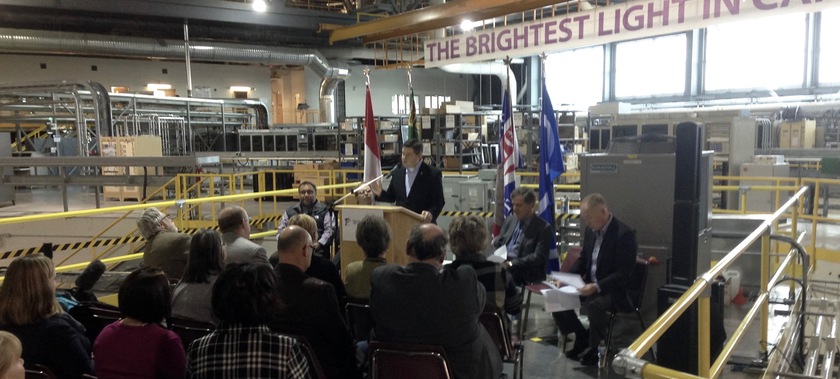Innovation Saskatchewan and the Petroleum Technology Research Centre (PTRC) today announced funding for an innovative research collaboration headed by the University of Calgary and employing the Canadian Light Source (CLS) in Saskatoon. The project is unique in heavy oil research, since it will be the first time a synchrotron has been used to image a heavy oil system, offering a detailed visualization of the dynamics of foamy oil formation as a reservoir is depressurized. Understanding foamy oil formation, the key mechanism in heavy oil recovery, is crucial for optimizing recovery rates in these challenging reservoirs.
The project will focus on modeling the physics of foamy oil dynamics and will use the CLS to scan a pressure vessel representing a heavy oil reservoir under subsurface conditions. This model will then be used to design improved recovery processes for reservoirs that employ cold heavy oil production with sand (CHOPS), a process that often leaves gaps or “wormholes” in reservoirs that cause pressure drops and low recovery rates. From these experiments, the processes observed will be quantified into a computer model to aid operating companies in reservoir decision making, such as improving the rate of depressurization during production, and when to inject fluids and solvents to optimize oil flow.
“Continued research and innovation is key to the long-term viability of Saskatchewan’s oil and gas industry,” Minister Responsible for Innovation the Honourable Jeremy Harrison said. “We are pleased to invest in this project that has the potential to increase oil production in heavy oil reserves with very little investment in new equipment.”
“This is a potential game-changer,” said Ken From, CEO of the PTRC. “Both Saskatchewan and Alberta have low recovery rates from CHOPS wells. Being able to model in real time how heavy oil flows from these sandy reservoirs has never been achieved. We’re excited to see one of Saskatchewan’s great scientific assets, the Canadian Light Source, working on solutions for the oil industry.”
Total funding from Innovation Saskatchewan of $160,000, along with $100,000 from the PTRC’s Heavy Oil Research Network and in-kind support from both CLS and the University of Calgary bring the total project cost to $303,000.
“This is an exciting new venture that fits within our goal of enabling leading edge science and technology outcomes,” said Dr. Robert Lamb, CEO of the CLS. “It is even more heartening to see that we are developing this know-how in our own back yard for impact that is truly global.”
2 University of Calgary researchers will gain access to synchrotron tomography capabilities that have greater spatial resolution and clearer images than can be obtained with traditional CT imaging. The modelling activities will be done at the University of Calgary where innovative computer simulations of wormhole formation in heavy oil reservoirs have been developed in previous research projects funded by PTRC.
“Typically we recover only eight to 10 per cent of oil from heavy oil wells, leaving 90 per cent of the resource left in the ground,” said Ian Gates, head of Chemical and Petroleum Engineering at the University of Calgary’s Schulich School of Engineering. Gates’ research is part of the University of Calgary’s research strategy, Energy Innovations for Today and Tomorrow, which focuses on global challenges that ask for greater sustainability, efficiency and more energy alternatives. “By understanding how foamy oil evolves and learning how to manipulate its properties, we can use that knowledge to increase production. This could result in accessing millions of dollars’ worth of heavy oil in a cost effective and environmentally friendly way as it means extending the life of existing oil wells.”
For more information contact:
Norman Sacuta Communications Manager
Petroleum Technology Research Centre
306.787.7497 Cell: 306.502.2101 norm.sacuta@ptrc.ca http://ptrc.ca


